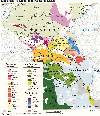| The Avar people |
Azerb.com
|
 The
15.000 Avar of Azerbaijan belong to a much larger group of Avar, totalling
over 600.000. This larger group, which inhabits the Caucasus Mountain regions
covers some fifteen distinct ethnic groups. Most of the Avar live in the
mountains, plains and foothills of Dagestan.
The
15.000 Avar of Azerbaijan belong to a much larger group of Avar, totalling
over 600.000. This larger group, which inhabits the Caucasus Mountain regions
covers some fifteen distinct ethnic groups. Most of the Avar live in the
mountains, plains and foothills of Dagestan.
The Avar of Azerbaijan live primarily in the northern Belokany and Zaqatala districts. Originally from Dagestan, these Avar moved further south in search of better pastures for their herds. They eventually formed free communities in Azerbaijan.
The Avar played an important role in the area's history. During the 3rd century B.C., fighting broke out between Persia and the people of the northern Caucasus, which included the Avar. They became a powerful community formed in the mountain regions. The Avar rulers lived in Khunzakh, Dagestan's capital until 1834. Their ability to control the river valleys and central plateau area gave them dominion over the highland peoples.
Most of the Avar are herdsmen rather than farmers. They exchange animal products for other necessary goods. Different types of animals are bred, depending on the area where the Avar live. For example those who live in the lowland areas generally have herds of livestock, while those in the high mountains regions raise large flocks of sheep. meat and dairy products form the basis of the diet for those in the mountain regions, while those in the valleys live on vegetable and grain products.
The Avar are very dedicated to family values. The basic unit of their society is the villages community, which is administered by the village assembly and a council of the elders. Most villages are located in the mountain slopes, and the two or three story houses and fortress like towers are made mostly of stone. In some houses cattle are kept on the ground floor. The roof of one house often serves as the courtyard for another upper house.
Within Avar society, the division of labour remains distinct but does show some signs of change. The men do the heavier work, such as house building, ploughing, threshing, transporting the harvest, and maintenance, while all domestic work is done by the women.
Girls generally marry at about fifteen years of age; and while the wishes of their parents play a basic role in the selection of the partners, personal preference is often considered. The formal right to divorce traditionally belonged to the husband, but now marriage can be dissolved by either partner.
The traditional clothing of the Avar is similar to that of other European groups and includes a felt cloak and quilted coat. Women wear special head-dresses called 'chikhtas'. Today, especially in Azerbaijan, most people wear ordinary Western-style clothes.
The Avar language is composed of five main dialects that are not mutually intelligible. Several attempts have been made to compile an Avar script based first on Arabic, then Latin, and then Cyrillic. Today, there is a well developed literature available in a literary language called 'Bolmata', which is based on the northern dialect.
Between the 5th and 12th centuries Georgian Orthodox Christianity was introduced to the Avar, however Sunni Islam has been their prevailing religion since the 13th century. Two important holy places are located within their region. Also, there are many Islamic schools. The mystic Sufi orders arrived in the area in the early 19th century, and today they are organized along patriarchal lines.
sources: multimap, bethany
| see also: Zaqatala, Tatar, Kurd, Tat, Lezgin, Talysh, Talysh, Tsakhur, maps, people, places, Islam, photos |
| A to Z of Azerbaijan / A dan Z ye Azerbaycan |
www.azerb.com
|